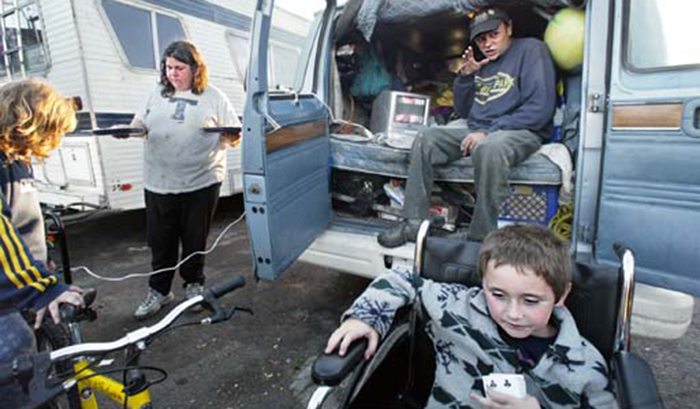Sadly, the sight of people sleeping on the streets, begging strangers for money and scavenging for food in the trash has become all common.
In Los Angeles County, 44,000 people are homeless on any night, many of them families.
This crisis has been building for decades, driven by declining incomes and rising housing costs. A startling one in four Angelenos nlives in poverty.
The County has half a million more very low-income households than available apartments. The typical monthly rent has skyrocketed 27 percent since 2000. The typical renter’s monthly income plunged 7 percent during the same period, partly due to the Great Recession.
These days, a typical household must earn $80,000 a year to afford the $2,000 average monthly rent sought by landlords, and still be able to buy groceries, pay for utilities, and other expenses.
Even preschool teachers, medical assistants, emergency medical technicians, paramedics, and many others with full-time jobs cannot afford to live in the County. The most vulnerable – those with mental or physical disabilities and drug or alcohol addiction, and who lack family support – are the hardest hit.
The problem is particularly acute in the County’s 2nd District, mine, which accounts for one-third of the County’s homeless population, according to the 2015 Homeless Count.
I have a moral imperative, a political responsibility to make the fight against homelessness a priority.
We have a good idea of what works – a humane, holistic approach that is fiscally sustainable, aimed not only at housing the homeless but preventing people from becoming homeless in the first place.
Since the beginning of my tenure at the Board of Supervisors in 2008, I have pursued a three-pronged strategy:
- Building strong and coordinated crisis response systems to get people back on their feet;
- Creating affordable housing with, if necessary, supportive services such as mental health and substance abuse treatments, and even job training and placement, in partnership with community-based organizations; and
- Putting money in people’s pockets by raising wages and spurring economic development that creates jobs easily accessible through public transit.
The Board of Supervisors’ most recent initiative set aside $4 million for teams of social workers and health professionals to go out into the streets of Skid Row and connect homeless single adults to housing and supportive services.
Separately, the Board of Supervisors redirected $7 million from underperforming County programs for homeless families, plus $10 million in other funds, to support the innovative Family Solutions System. Over the past year, it has rapidly rehoused 1,000 families, only 6 percent of whom have fallen back into homelessness.
More than 1,900 new affordable housing units have been constructed over the past six years in the 2nd District alone.
In 2013, $1 million in 2nd District funds jumpstarted the County’s Flexible Housing Subsidy, giving homeless patients a path to independent living after their discharge from County hospitals. The subsidy has been so successful that the County now invests $4 million a year to keep it going. So far, 1,000 units have been made available and another 1,500 units are expected to be available by next summer.
An important tool for is temporary residential options like Recuperative Care beds to care for homeless patients after they leave hospital. About $1.8 million has been invested in renovating and operating 40 recuperative care beds in South Los Angeles. Another 100 beds will open at the Martin Luther King, Jr. Medical Campus in December.
We are expanding Psychiatric Urgent Care Centers to reduce the pressure on Psychiatric Emergency Departments. We opened another such center at the MLK campus in 2014, and are renovating another in Culver City that will open in December.
We are chipping away at income inequality and the disparity between wages and housing costs. The Board of Supervisors has adopted policies to ensure County-funded construction jobs, such as those at the Martin Luther King, Jr. Community Hospital, go to local residents.
The Board has adopted motions to ensure employees of County contractors, as well as homecare workers who look after our elderly and disabled, receive a just or living wage.
Given the magnitude of the homeless crisis, however, it is time to scale up.

